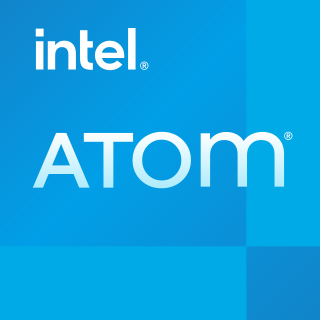
Walkman, stylised as WALKMAN (ウォークマン), is a brand of portable audio players manufactured and marketed by Sony since 1979. The original Walkman was a portable cassette player and its popularity made "walkman" an unofficial term for personal stereos of any producer or brand. By 2010, when production stopped, Sony had built about 200 million cassette-based Walkmans. The Walkman brand was extended to serve most of Sony's portable audio devices, including DAT players, MiniDisc players/recorders, CD players, transistor radios, mobile phones, and digital audio/media players. As of 2022 the Walkman range consists exclusively of digital players.
Adaptive Transform Acoustic Coding (ATRAC) is a family of proprietary audio compression algorithms developed by Sony. MiniDisc was the first commercial product to incorporate ATRAC in 1992. ATRAC allowed a relatively small disc like MiniDisc to have the same running time as CD while storing audio information with minimal loss in perceptible quality. Improvements to the codec in the form of ATRAC3, ATRAC3plus, and ATRAC Advanced Lossless followed in 1999, 2002, and 2006 respectively.

The Memory Stick is a removable flash memory card format, originally launched by Sony in late 1998. In addition to the original Memory Stick, this family includes the Memory Stick PRO, a revision that allows greater maximum storage capacity and faster file transfer speeds; Memory Stick Duo, a small-form-factor version of the Memory Stick ; the even smaller Memory Stick Micro (M2), and the Memory Stick PRO-HG, a high speed variant of the PRO to be used in high-definition video and still cameras.
Sony Mobile Communications Inc. is a multinational telecommunications company founded on October 1, 2001, as a joint venture between Sony Group Corporation and Ericsson. It was originally incorporated as Sony Ericsson Mobile Communications, and headquartered in London, England, until Sony acquired Ericsson's share in the venture on February 16, 2012. On April 1, 2021, Sony integrated its electronics businesses including Sony Mobile into one company called Sony Corporation.

SonicStage is a discontinued software from Sony that is used for managing portable devices when they are plugged into a computer running Microsoft Windows. It comprises a music player and library manager, similar to iTunes, Windows Media Player and RealPlayer. It is used to manage the library of ATRAC and MP3 recordings on a PC. It was first used in VAIO PCs put on the Japanese market in October 2001, and superseded OpenMG Jukebox. Version 2 was found on 2004 model products, and Version 3 on 2005 model products. SonicStage was required to transfer and manage music on all Network Walkman, NetMD and Hi-MD players, and the Clie handheld, before the software was dropped entirely outside of Japan in 2007.

Intel Atom is the brand name for a line of IA-32 and x86-64 instruction set ultra-low-voltage processors by Intel Corporation designed to reduce electric consumption and power dissipation in comparison with ordinary processors of the Intel Core series. Atom is mainly used in netbooks, nettops, embedded applications ranging from health care to advanced robotics, and mobile Internet devices (MIDs). The line was originally designed in 45 nm complementary metal–oxide–semiconductor (CMOS) technology and subsequent models, codenamed Cedar, used a 32 nm process.

Xperia is the brand name of smartphones and tablets from Sony. The name Xperia is derived from the word "experience", and was first used in the Xperia X1 tagline, "I Xperia the best".

The Xperia Play is a smartphone with elements of a handheld game console produced by Sony Ericsson. With the marketshare for dedicated handheld game consoles diminishing into the 2010s due to the rapid expansion of smartphones with cheap downloadable games, Sony attempted to tackle the issue with two separate devices; a dedicated video game console with elements of a smartphone, called the PlayStation Vita, and a smartphone with elements of a handheld console, the Xperia Play. Originally rumored to be a "PlayStation Phone", the device shed the "PlayStation" branding in favor of the Xperia brand, running on the Android operating system.

Xperia Tablet, formerly known as Sony Tablet, is the brand name of a series of tablet computers. The first models used to run Google's operating system Android 3.1 Honeycomb, but more recent models operate on the Android 4.1.2 system. The first models were informally announced on 26 April 2011, using the code names, by the Sony Corporation in the Sony IT Mobile Meeting. They featured touchscreens, two cameras, infrared sensor, Wi-Fi. Also, they support PlayStation Suite, DLNA, and are 3G/4G compatible. The retail price in the U.S at the time of release was US$499–599. In Europe, prices were at €499. To increase the number of apps available and provide marketing support for both tablets, Sony and Adobe Systems will hold a $200,000 competition targeting app developers. The series was formally launched in Berlin and Tokyo on 31 August 2011. The latest in the series is the Xperia Z4 Tablet.
Lenovo smartphones are marketed as the "LePhone" in Mainland China and the "IdeaPhone" overseas. Motorola Mobility, ZUK Mobile and Medion, divisions of Lenovo, sell smartphones under their own brands. As of September 2015, Lenovo is in the process of rebranding most of its phones using the Motorola brand name.

The Tablet S is the first modern tablet computer released by Sony. Featuring a "unique asymmetric design", the Tablet S runs Google's Android Ice Cream Sandwich 4.0 operating system and features a 9.4 in (240 mm) multitouch display, 1 GHz Nvidia Tegra 2 dual core processor, Wi-Fi ability, front- and rear-facing cameras, Bluetooth, and an infrared sensor. It is also configured with access to the Sony Entertainment Network and is PlayStation Certified and Digital Living Network Alliance (DLNA) compatible. Tablet S was first released in September 2011. It was succeeded by the Xperia Tablet S, which would be created by Sony's new subsidiary Sony Mobile.

The Sony Ericsson Live with Walkman is an Android smartphone from Sony Ericsson. It is a music-focused smart phone running Android 2.3, powered by a 1 GHz processor. The screen is 3.2" TFT with HVGA resolution and scratch-resistant coating. The phone measures 56.5 x 106 x 14.2 mm and weighs 115g, making it slightly taller and heavier than the Xperia mini but its specs are similar.

The Sony Xperia Z was announced by Sony at CES 2013 and was released on 9 February 2013 in Japan and 1 March 2013 in Singapore and the UK. The Xperia Z was initially shipped with the Android 4.1.2 operating system. The smartphone has Ingress Protection Ratings of IP55 and IP57, making it dust protected, low pressure water jet protected, and waterproof, which allows for immersion under 1 meter of water for up to 30 minutes. It also contains a 13.1 MP Exmor RS camera sensor as well as a TFT 1980x1080 display with 441 PPI.

The Xperia Tablet Z is a touchscreen Android tablet designed and manufactured by Sony and was first announced in Japan in January 2013. It was then announced globally in Barcelona at the Mobile World Congress on February 25, 2013. The tablet is one of the lightest and thinnest 10.1-inch tablet in the world with a weight of 1.09 pounds and is just 0.27 inches thick. The Tablet Z succeeds the Xperia Tablet S with a faster processor, a better front-facing camera, a higher-resolution screen, and Ingress Protection Ratings of IP55 and IP57, for dust-protected, water-jet protected, and waterproof in up to one meter of water for up to thirty minutes. It was released in May 2013. The device retails at $500 for the 16GB version and $600 for the 32gb version.

The Sony Xperia Z3 Compact is an Android smartphone produced by Sony. As part of the Z Series, the Z3 Compact is a scaled-down version of the Sony Xperia Z3 and was unveiled during a press conference in IFA 2014 on 4 September 2014. Like the preceding Z1 Compact, the Z3 Compact is water-proof with an IP rating of IP65 and IP68. The phone features a new display, a Qualcomm Snapdragon 801 processor, and has the ability to record 4K videos.
The Walkman A Series is a flagship line of mid-range digital audio players (DAP) by Sony as part of its Walkman range. The A Series has been marketed since 2005, initially as the top spec Walkman players and since 2014 as a mid-range following the introduction of the ZX Series. The "A" originally stood for "All in one, Advanced, and Attractive".

The Walkman F series is a discontinued portable media player manufactured as a part of Sony's Walkman line of music players, through two generations. They are high-res compatible players and run the Android operating system.
The Walkman E Series is a line of digital audio (DAP) and portable media (PMP) players, marketed by Sony as part of its Walkman range. E Series devices have been marketed since 2000, although in its current form since 2008 as entry-level, candybar styled players.











